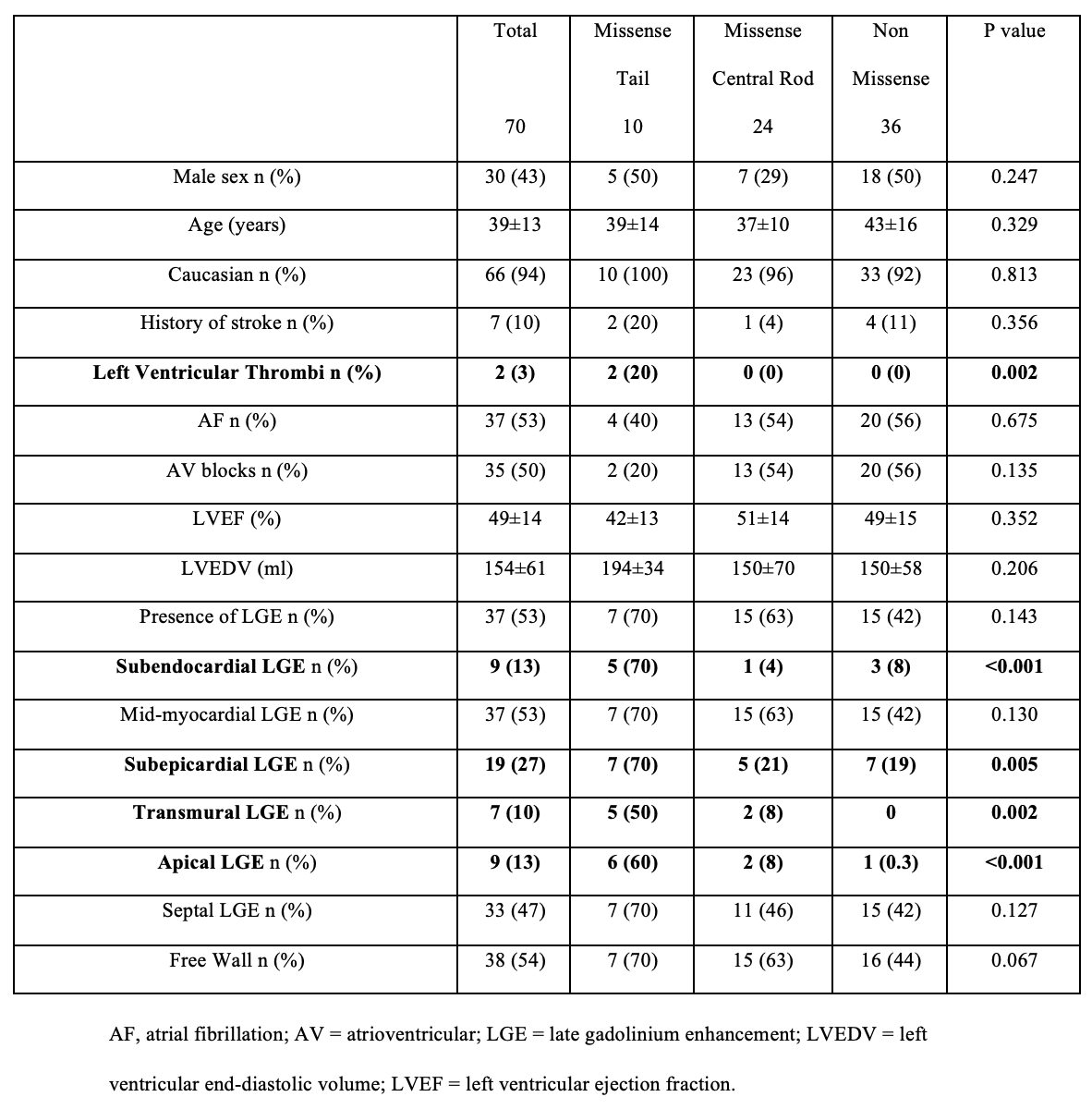Final ID: Su1040
Prevalence, Genetic Correlates and Prognostic Significance of an Apical Pseudo-Infarct Late Gadolinium Enhancement Pattern in LMNA-Mediated Cardiac Laminopathy
Abstract Body (Do not enter title and authors here): Background: Disease-causative variants in LMNA-encoded lamin A/C cause a genetic cardiomyopathy characterized by atrioventricular (AV) block, atrial fibrillation (AF) and ventricular arrhythmias (VA). Whether domain/variant-specific late gadolinium enhancement (LGE) patterns exist and carry prognostic significance is unclear.
Objective: To determine if specific LGE patterns correlate with LMNA variant type/missense variant localization and clinical outcomes in a large cohort of cardiac laminopathy patients.
Methods: Retrospectively, 621 genotype-positive arrhythmogenic/dilated cardiomyopathy patients were analyzed to identify those with a disease-causative variant in LMNA-encoded lamin A/C. After exclusion of patients without cardiac magnetic resonance data, pertinent demographic/clinical data was extracted from the electronic medical record. LGE distribution (subepicardial, midmyocardial, subendocardial, transmural) and location (septal, free wall, apical) patterns were analyzed by variant type (missense vs truncating) and missense variant localization (central rod domain vs tail domain) and correlated with advanced heart failure (AHF), MVA, AV block, AF and thromboembolic (TE) events.
Results: 70 out of 116 (60%) LMNA variant-positive (mean age 39±12, 43% male and 94% Caucasian) were included. Missense variants localizing to the C-terminal tail region showed a higher prevalence of transmural and apical LGE (Table). Amongst the 5 (7%) patients with this distinct apical pseudo-infarct LGE pattern, p.Arg471His-LMNA was identified in all cases. Among the 48/70 (69%) of patients with clinically manifest disease, p.Arg471His-LMNA-positive patients (n=6) were noted to have an increased prevalence of TE events [3 (50%) vs 5 (12%), 0=0.050] despite a reduced prevalence of AF [2 (33%) vs 32 (76%), p= 0.031]. No difference in AHF or MVA were observed, but AV block was less prevalent [1 (20%) vs 29 (74%), p= 0.029].
Conclusion: p.Arg471His-LMNA causes a distinct apical pseudo-infarct LGE pattern associated with an increased risk of TE events and a decreased prevalence of AV block and AF. Future studies are needed to better refine the role of domain/variant-specific risk-stratification/anticoagulation in cardiac laminopathy.
Objective: To determine if specific LGE patterns correlate with LMNA variant type/missense variant localization and clinical outcomes in a large cohort of cardiac laminopathy patients.
Methods: Retrospectively, 621 genotype-positive arrhythmogenic/dilated cardiomyopathy patients were analyzed to identify those with a disease-causative variant in LMNA-encoded lamin A/C. After exclusion of patients without cardiac magnetic resonance data, pertinent demographic/clinical data was extracted from the electronic medical record. LGE distribution (subepicardial, midmyocardial, subendocardial, transmural) and location (septal, free wall, apical) patterns were analyzed by variant type (missense vs truncating) and missense variant localization (central rod domain vs tail domain) and correlated with advanced heart failure (AHF), MVA, AV block, AF and thromboembolic (TE) events.
Results: 70 out of 116 (60%) LMNA variant-positive (mean age 39±12, 43% male and 94% Caucasian) were included. Missense variants localizing to the C-terminal tail region showed a higher prevalence of transmural and apical LGE (Table). Amongst the 5 (7%) patients with this distinct apical pseudo-infarct LGE pattern, p.Arg471His-LMNA was identified in all cases. Among the 48/70 (69%) of patients with clinically manifest disease, p.Arg471His-LMNA-positive patients (n=6) were noted to have an increased prevalence of TE events [3 (50%) vs 5 (12%), 0=0.050] despite a reduced prevalence of AF [2 (33%) vs 32 (76%), p= 0.031]. No difference in AHF or MVA were observed, but AV block was less prevalent [1 (20%) vs 29 (74%), p= 0.029].
Conclusion: p.Arg471His-LMNA causes a distinct apical pseudo-infarct LGE pattern associated with an increased risk of TE events and a decreased prevalence of AV block and AF. Future studies are needed to better refine the role of domain/variant-specific risk-stratification/anticoagulation in cardiac laminopathy.
More abstracts on this topic:
A Genome-wide CRISPRi Screen Implicates Coronary Artery Disease GWAS Genes as Key Regulators of Adventitial Fibroblast Proliferation
Jackson William, Zhu Ashley, Gu Wenduo, Berezowitz Alexa, Iyer Meghana, Cheng Paul
9p21.3 variants drive coronary calcification by suppressing statherin expressionSoheili Fariborz, Almontashiri Naif, Heydarikhorneh Niloufar, Vilmundarson Ragnar, Chen Hsiao-huei, Stewart Alexandre

